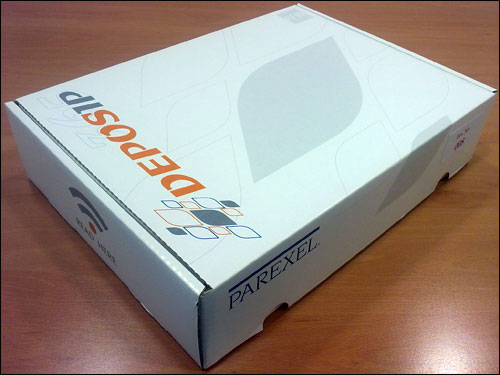Parexel International, a global biopharmaceutical services organization, has completed a proof of concept of a system using RFID to determine the technology’s ability to ensure a drug’s temperature has not exceeded safe thresholds while being shipped to participants in clinical trials. As a follow-up to that trial, the company plans to launch a pilot later this year that will involve tagging actual pharmaceuticals and tracking them throughout the supply chain to hospitals around the world.
Parexel will employ active RFID tags with temperature sensors and a mobile phone to access information regarding a trial product’s temperatures during transit. If the follow-up study finds that the RFID system is effective at providing temperature data, the firm hopes to launch the solution for its pharmaceutical company customers. The temperature tracking would be used to ensure that new products being tested had not been too warm or too cold during shipment from manufacturers to clinical locations where the drugs are being administered.

For the past three years, says Jens Mattuschka, Parexel’s director of clinical logistics services worldwide, the company had been considering the implementation of an RFID solution to track the temperatures of new medications being transported to the locations of clinical trials for the pharmaceutical industry. For a trial involving a single drug, Parexel may ship the product being tested to hundreds or thousands of locations around the globe at which trials are held. The drug is typically manufactured in a small quantity, and then sent to those locations, shipped either by truck or air. Part of the service that Parexel provides is ensuring that the temperature does not exceed safe thresholds while in transit.
Clinical trial medications can be sensitive to temperature changes, and the level of that sensitivity may not be as well known as that for approved medications. Therefore, it is critical to have temperature data for some of these products before they given to patients. Verifying that the drugs have been stored at the proper temperature, says Kurt Norris, the company’s corporate VP, ensures that the medication quality has not been adversely affected—something that could pose a health risk for those who take the medication as part of a trial.
Currently, therefore, the process typically requires that a box of product be shipped with a temperature logger inside the box, in order to read the temperature. When the investigator or physician (the individual who will be conducting the trial) opens the box, he or she must remove the logger, read it visually and input the temperature displayed on that device into a software program designed by Parexel for tracking the drugs’ temperature. That individual must then send that information via the Internet to Parexel’s server, where it must be reviewed, analyzed and either approved or rejected. Alternatively, data can be downloaded via a USB interface to a computer, and then be uploaded to the Parexel server via the Internet.The system has multiple flaws, however. For one thing, it’s time-consuming, as employees are responsible for either visually reading the loggers and recording the data, or downloading that information via a USB cable. Typically, by the time that function has been completed and Parexel receives the data and either approves the product or rejects it, 24 hours have passed. That, Norris says, results in waiting time for investigators. “We’re responsible for ensuring the integrity of the drug,” he states.
Regulations have been getting more stringent regarding the environmental conditions of the products as they ship, Norris says, while pharmaceutical companies have been seeking a solution that would make their supply chain safer and more efficient.
Earlier this year, Parexel began developing a solution that utilizes active 13.56 MHz tags complying with the ISO 14443a and 15693 standards, and supports the Near Field Communication (NFC) specifications. The challenge, the company reports, was to develop a solution that would be easy to use by trial investigators, and that would operate in any part of the world. The system Parexel developed employs Cypak‘s CPK082 NFC sensor chip in a mobile phone to receive transmissions from the tag and the phone, and then forward that data to Parexel’s server via a cellular connection.
During the proof-of-concept pilot, held earlier this year, liquid-filled bottles (actual medications were not used during the pilot) were encased in packaging provided by Parexel that included two layers of corrugated paper placed inside a cardboard box, along with a temperature sensor that is wired to an RFID tag embedded in one side of that box. The tag was activated by a pharmacist specializing in shipment preparation for investigational medicinal products, using an RFID-enabled Nokia mobile phone, and the date and time stamp for this activation were sent to Parexel’s server.
The box packed with the bottles was then placed in a carton, along with a Nokia mobile phone. Throughout the supply chain—from a depot in Europe to the receiving party, which was typically a health-care provider or a pharmaceutical company—the sensor read the temperature within the box at a rate of once every 10 minutes. The RFID tag then stored that information, along with date and time stamps. When the carton reached its destination, the clinical investigator—in most cases, a physician—unpacked the mobile phone and turned it on, then waved the phone, with a built-in NFC reader, over the box, thereby capturing the RFID tag’s ID number, as well as the temperature data stored in its memory.Once finished, the investigator pressed a button on the mobile phone to instruct the phone’s software to transmit the data to Parexel’s server via a GSM connection. Parexel software then interpreted the sensor data, and if the software detected a temperature outside of the acceptable range, it issued an alert to Parexel’s staff. Had this been an actual clinical trial, and had the temperature throughout the supply chain proven to be acceptable, the product would then have been approved for use by the trial’s participants—with the entire process completed in a matter of minutes, rather than the 24 hours required when using the manual method.
During the proof-of-concept study, Mattuschka says, the liquid was shipped in the NFC-enabled packaging from Europe to 10 to 20 locations in Latin America and the United States. The technology properly tracked temperatures throughout the journeys, he adds, which extended up to 72 hours.
For the follow-up study, expected to be held later this year, the company will identify one clinical pharmaceutical product, and track it to the investigators or physicians who will conduct clinical trials for the biopharmaceutical industry throughout the world. Each investigator will receive training for the handling of clinical trial pharmaceuticals—and in this case, the training will include how to operate the cell phone to read and then transmit temperature data to Parexel’s server.
Eventually, Norris says, Parexel would like to use RFID technology to track temperatures for all clinical trials involving temperature-sensitive products. The system will provide cost savings, he indicates, by reducing the amount of labor needed to read, interpret and input temperature data. He adds that it will also save time, by reducing the amount of time that investigators must await temperature results. What’s more, the system will enable greater visibility not only into a product’s temperature range, but also when the temperature changes occur, and when the product is shipped and then received.


